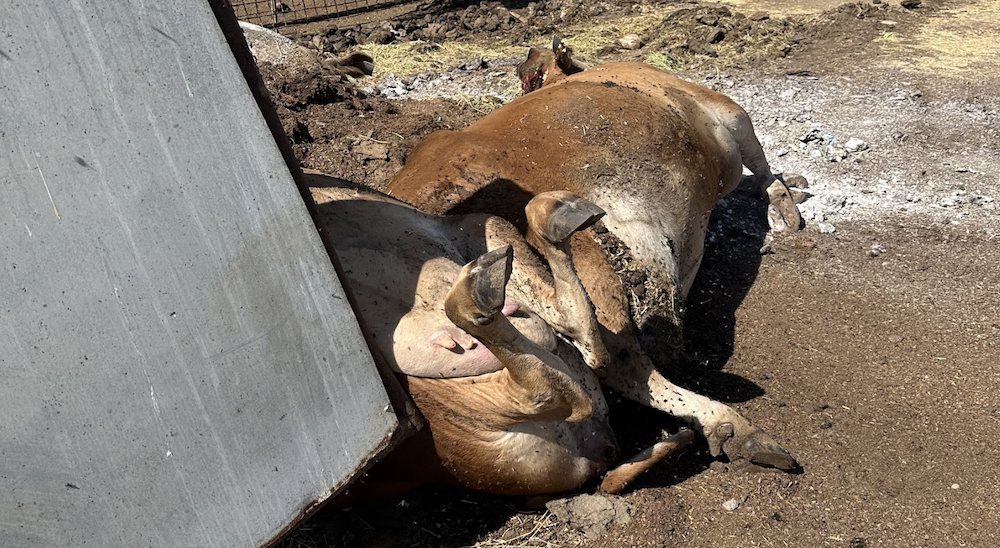
Cows dead from bird flu sit by the side of a road at a Tulare County dairy. Photo by Crystal Heath
Written by Frank Lopez
There are 131 dairy farms in Central California that have been confirmed to have cases of H5N1 Bird Flu in their herd.
That’s according to the California Department of Food and Agriculture (CDFA) as of Monday.
As of Oct. 18, the California Department of Public Health (CDPH) has confirmed 13 human cases of bird flu in California amongst dairy workers.
In these cases, all individuals had contact with animals at different farms and have experienced mild symptoms including eye redness, or conjunctivitis.
According to CDPH, additional human cases of bird flu are expected to be identified and confirmed in the state among individuals who have had contact with infected dairy cattle.
The nationwide outbreak of bird flu began in poultry in 2022 and was first detected in US dairy cattle in March.
Infected cattle may show clinical signs that include a decrease in feed consumption, respiratory signs, an acute drop in milk production, lethargy, dehydration and fever.
According to the CDFA, in March, the was a single bird flu incident in a dairy cow in Texas, with that being the single point infection leading to the nationwide outbreak.
Ryan Jacobsen, CEO of the Fresno County Farm Bureau, said the bird flu is a major concern for dairy farmers in the Central Valley.
“When it gets to a facility, it spreads very quickly among the cattle,” Jacobsen said.
Jacobsen said that California had the benefit of time to prepare for bird flu, as opposed to states in the Midwest that were affected earlier.
Jacobsen said that dairy cows that do recover from the bird flu do not return to the same levels of production, and its likely they’ll have to go through a calving cycle before their production levels return.
He said that there are a lot of questions about how the virus will affect the dairy industry in the immediate and long term, but it’s likely to have some effect on California’s supply of milk in the short term.
While the effect on prices is yet to be seen, Jacobsen noted that there is a historical slight decline in milk consumption in the fall and winter months.
In response to the outbreak, dairy facilities are taking the the highest biosecurity measures they can to try to minimize traffic on to their farms, such as ensuring that incoming cows are quarantined.
“It’s important to note that our food supply is safe,” Jacobsen said. “Pasteurization of milk kills the virus.”
The virus has been an “incredible drain on human resources” for dairy facilities due to the required treatment for cows and having to do it daily and consistently.
Dairy workers are working overtime to get cows back to health.
Along with the costs for medicine and care, there is also the cost of reduced milk production.
“We are still figuring out what this means going forward,” Jacobsen said.
On Oct. 8, Crystal Heath, co-founder and director of Our Honor, a nonprofit veterinary organization based in Los Angeles, travelled to Tulare County and took photographs of dead cows on a road at a dairy.
Anja Radabaugh told ABC 30 that 10-15% of the state’s 1.7 million dairy cows have died as a result of the infection.
Radabaugh, CEO of Western United Dairies, didn’t respond to requests for comment.
With strict quarantines put on dairies by the U.S. Department of Agriculture, more stringent biosecurity measures have also been put in place, including more sanitation and the use of personal protective equipment for workers.
Rendering trucks are reportedly unable to keep up with demand. Rendering is the process of converting animal byproducts and inedible materials into usable products such as animal feed, pet food and more.
Dr. Carmen Licon, director of the Dairy Products Technology Center at Cal Poly San Luis Obispo, said the pasteurization of milk kills the bird flu virus and makes it safe to drink.
As always, health officials are warning the public to eat only pasteurized dairy products.
“Raw dairy producers sales are down. Another concern is not having enough scientific data to back the fact of where the virus can grow with prevalence. We don’t know,” Licon said.







